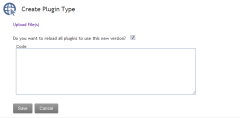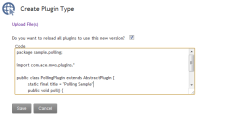Add or Update Plugin Types
Plugin types can be uploaded into Moab Web Services using a Groovy file, a Java Archive (JAR) file, or pasted Groovy code. To access the plugin type upload page, navigate to the Plugin Type List page and click Add or Update Plugin Type. The default interface of this page enables the uploading of a single Groovy class file or a JAR file.
When a plugin type is updated, by default all corresponding plugins created from the plugin type will be recreated. If this behavior is not desired, clear the Do you want to reload all plugins to use this new version? checkbox before uploading the plugin type.
Single class file
Groovy files containing a single plugin type may be uploaded at the /mws/admin/plugin-types/create URL.

|
|
Click to enlarge |
If the upload failed or an error occurred during initialization of the plugin, an error message will be displayed.

|
|
Click to enlarge |
JAR file
A JAR file, as described in Packaging Plugins, containing one or more plugins may also be uploaded using the same process as the Groovy file.
Click Add files..., select the .jar file, and click the Start upload button. If the upload failed or an error occurred during initialization of the plugin(s), an error message will be displayed.
The JAR upload process differs from the single file in that if successful, the name of the JAR file itself is displayed instead of the plugin name(s).

|
|
Click to enlarge |
Code
To paste or type code directly into MWS and have it be loaded as a single class file, click Type or Paste Code, and type or paste the code into the presented text box.

|

|
|
Click to enlarge |
When the code is in the box, click Create. If the upload succeeded and the code was able to be compiled as Groovy, the browser will be redirected to the Show Plugin Type page. If the upload failed or an error occurred during compilation or initialization of the plugin, an error message will be displayed.
You may need to refer to the MWS log file for additional details and error messages in the case of a failure.
Related Topics